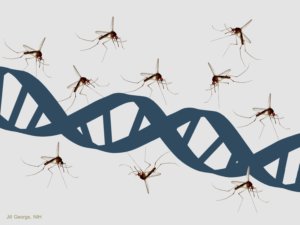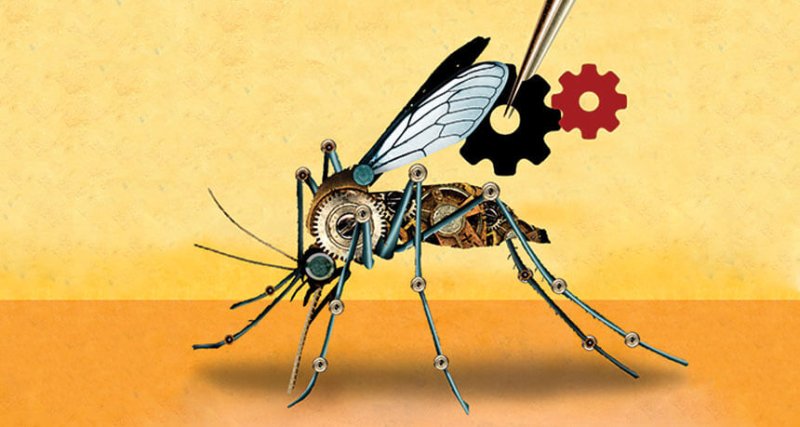Side 1–Gene drives are a valuable tool for controlling pests and perpetuating beneficial genes through agricultural products
Side 2–Gene drives are a dangerous, untested and unnatural genetic changes created to “deliberately drive a species to extinction.”
“Gene drive” is a version of gene editing—a newer, more precise way to change a DNA (or RNA) sequence, in this case by combining a guide RNA with an enzyme that can make a splice in the exact place where a sequence can be removed, another sequence inserted, or the existing sequence altered. Gene drive takes this to another level, making sure that a new or altered genetic sequence has a greater than 50 percent chance of being inherited. This can be done in a number of ways, some of which already exist in nature, some which are no different than “traditional” gene editing using CRISPR-Cas9, and others that have triggered a backlash from environmental activist groups—non-governmental organizations (NGOs) that utilize fear for their own political ends.
So far, this debate has pitted NGOs like Friends of the Earth, Greenpeace and ETC Group (who are opposed to any genetic manipulations in food crops and animals) against scientists, some agricultural companies and even some government regulators (almost all of whom conclude that these products are no more dangerous than those developed through traditional breeding).
The activist effort is part of a long-standing campaign to conflate gene drives, gene editing and traditional transgenics (GMO) as the same technology, with the same scientific certainty (or uncertainty) and risks. In 2016, FOE and others asked for a worldwide moratorium on gene drives:
Gene drives, developed through new gene-editing techniques, are designed to force a particular genetically engineered trait to spread through an entire wild population – potentially changing entire species or even causing deliberate extinctions. The statement urges governments to put in place an urgent, global moratorium on the development and release of the new technology, which poses serious and potentially irreversible threats to biodiversity, as well as national sovereignty, peace and food security.
Many times, these activist organizations have claimed the public shares their concerns. Citing survey data, the science community has retorted that most people embrace biotechnology when they recognize that it benefits them directly. But what has been missing from the battle between the pro- and anti-GMO positions is a scientific measure of public opinion on more recent techniques such as gene drive. In 2016, a comprehensive National Academies of Science (NAS) report called for not only continued research on the effectiveness and usefulness of gene drives, but also their ecological risks and engagement with the public. While institutions like FOE and ETC Group objected to the existence of gene drives, they did not represent the opinion of the public.

For the first time, that opinion was actually tested, by researchers at North Carolina State University and the University of Wisconsin. In a paper published in Science Advances, Zack Brown, assistant professor of resource economics at NC State and his colleagues surveyed 1,000 American adults on their opinions of gene drives. What they found, instead of opposition, was support for the technology, with a few caveats:
- 61 percent of respondents supported gene drives that suppressed populations of non-native pests, while 57 percent supported drive drives that would result in replacement of non-native pests.
- Nearly 50 percent supported uncontrolled gene drives that eliminated native pest species (25 percent didn’t have a strong opinion).
- Respondents who sought non-GMO food were increasingly opposed to gene drives, but of the 20 percent of people who sought non-GMO foods, 52.8 percent supported gene drive applications in non-native species with controls on the drive’s spread.
The survey results could be valuable in this early stage of gene drive (or gene editing, for that matter) development as research could possibly be directed toward designing drive strategies that could incorporate controls—not an easy thing to do, Brown said in a press release.
“This is the right time—while the technology is still under development and before any release decisions have been made—to gain insights into what the public thinks, what types of information they prioritize from researchers, and who is trusted to carry out this sensitive research,” said Michael Jones, a graduate student at NC State and co-author of the published survey results.
Another significant finding in the NC State/Wisconsin study was that Americans surveyed trusted universities and the US Department of Agriculture (USDA) (60 percent) over foreign universities, the US Department of Defense (18 percent) and private companies (16 percent) to research gene drive systems.
The survey did not ask respondents for their trust levels of NGOs like FOE and Greenpeace.
However, in another recently published survey, this one in Current Research in Biotechnology, 113 experts (scientists, government officials, agribusiness professionals) found that gene-edited crops posed little to no risk to society, the economy, human health or the environment. Less than five percent thought the techniques posed a high risk.
The experts, most of whom observed that NGOs generally opposed gene editing, gene drive and any other genetic modification, noted that this opposition “is based on speculative risks, those that have no established theory or evidence data.” The authors of the study, based at the University of Saskatchewan in Canada, warned that the problem with “attempting to reconcile speculative risks with risks grounded in theory and evidence, is that speculative risks can be very fluid and dynamic, changing at will and [frequently] at the whim of eNGO political motives.”
These new studies seem to support the idea that consumers are less wary of biotechnology when they know how it’s being deployed. While public opinion surveys show support with some caveats about taking precautions against accidents and outbreaks, by and large members of the public trust scientists, particularly those in academia and at relevant regulatory agencies to navigate this controversial but promising field of research.
Andrew Porterfield is a writer and editor, and has worked with numerous academic institutions, companies and non-profits in the life sciences. BIO. Follow him on Twitter @AMPorterfield































